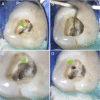Comparison of long-term survival of implants and endodontically treated teeth
- PMID: 24065635
- PMCID: PMC3872851
- DOI: 10.1177/0022034513504782
Comparison of long-term survival of implants and endodontically treated teeth
Abstract
The outcomes of both dental implants and endodontically treated teeth have been extensively studied. However, there is still a great controversy over when to keep a natural tooth and when to extract it for a dental implant. This article reviews the benefits and disadvantages of both treatment options and discusses success vs. survival outcomes, as well as the impact of technical advances for modern endodontics and endodontic microsurgery on the long-term prognosis of tooth retention.
Keywords: dental implants; endodontic therapy; oral health; outcome; systematic review; treatment planning.
Conflict of interest statement
The authors received no financial support and declare no potential conflicts of interest with respect to the authorship and/or publication of this article.
Figures



References
-
- Academy of Osseointegration (2010). Guidelines of the Academy of Osseointegration for the provision of dental implants and associated patient care. Int J Oral Maxillofac Implants 25:620-627 - PubMed
-
- Albrektsson T, Zarb GA, Worthington P, Eriksson AR. (1986). The long-term efficacy of currently used dental implants: a review and proposed criteria of success. J Oral Maxillofac Implants 1:11-25 - PubMed
-
- Alley BS, Kitchens GG, Alley LW, Eleazer PD. (2004). A comparison of survival of teeth following endodontic treatment performed by general dentists or by specialists. Oral Surg Oral Med Oral Pathol Oral Radiol Endod 98:115-118 - PubMed
-
- Avila G, Galindo-Moreno P, Soehren S, Misch CE, Morelli T, Wang HL. (2009). A novel decision-making process for tooth retention or extraction. J Periodontol 80:476-491 - PubMed
-
- Baek SH, Plenk H, Jr, Kim S. (2005). Periapical tissue responses and cementum regeneration with amalgam, super-EBA and MTA as root-end filling materials. J Endod 31:444-449 - PubMed
Publication types
MeSH terms
Substances
LinkOut - more resources
Full Text Sources
Other Literature Sources

